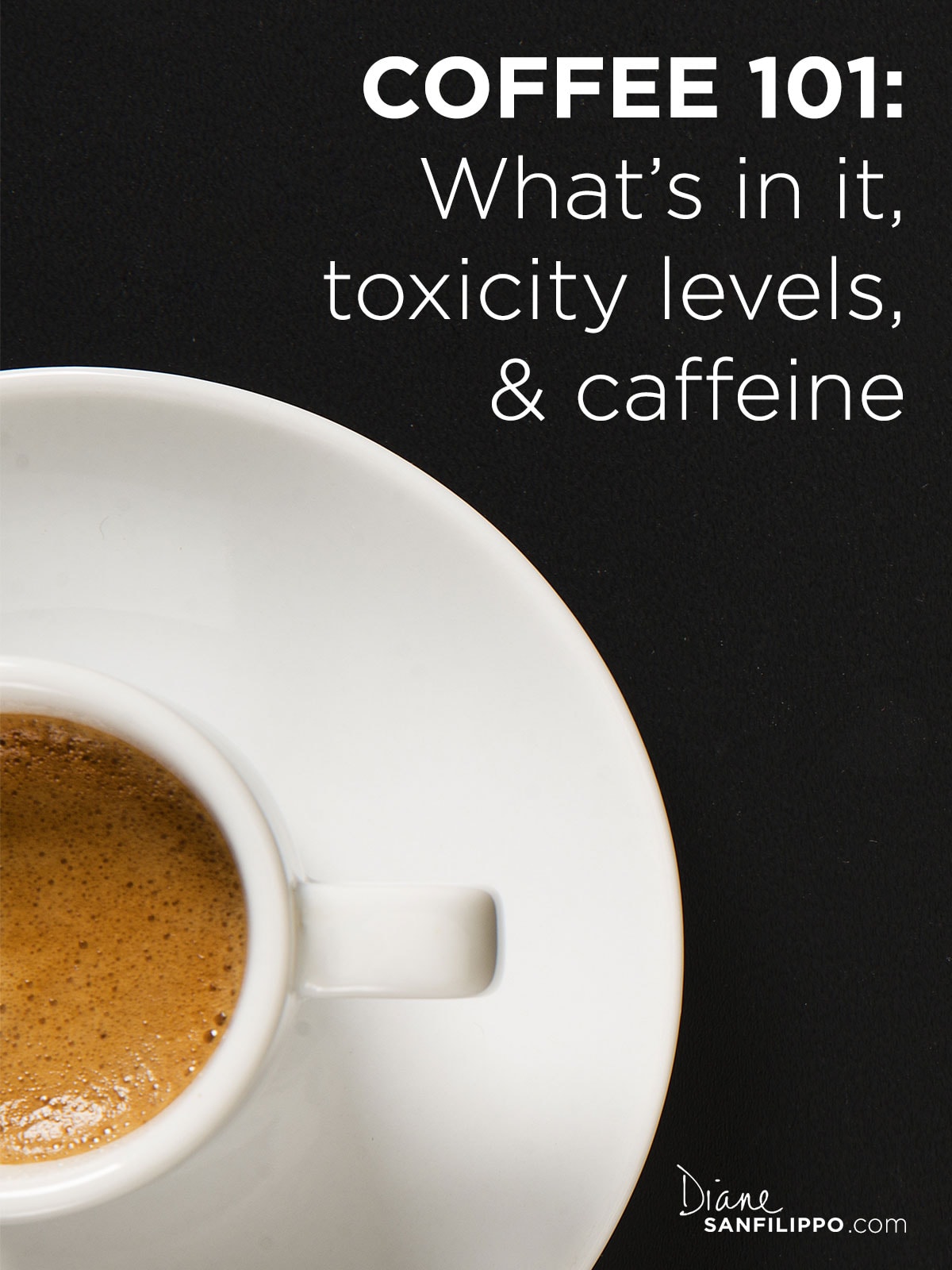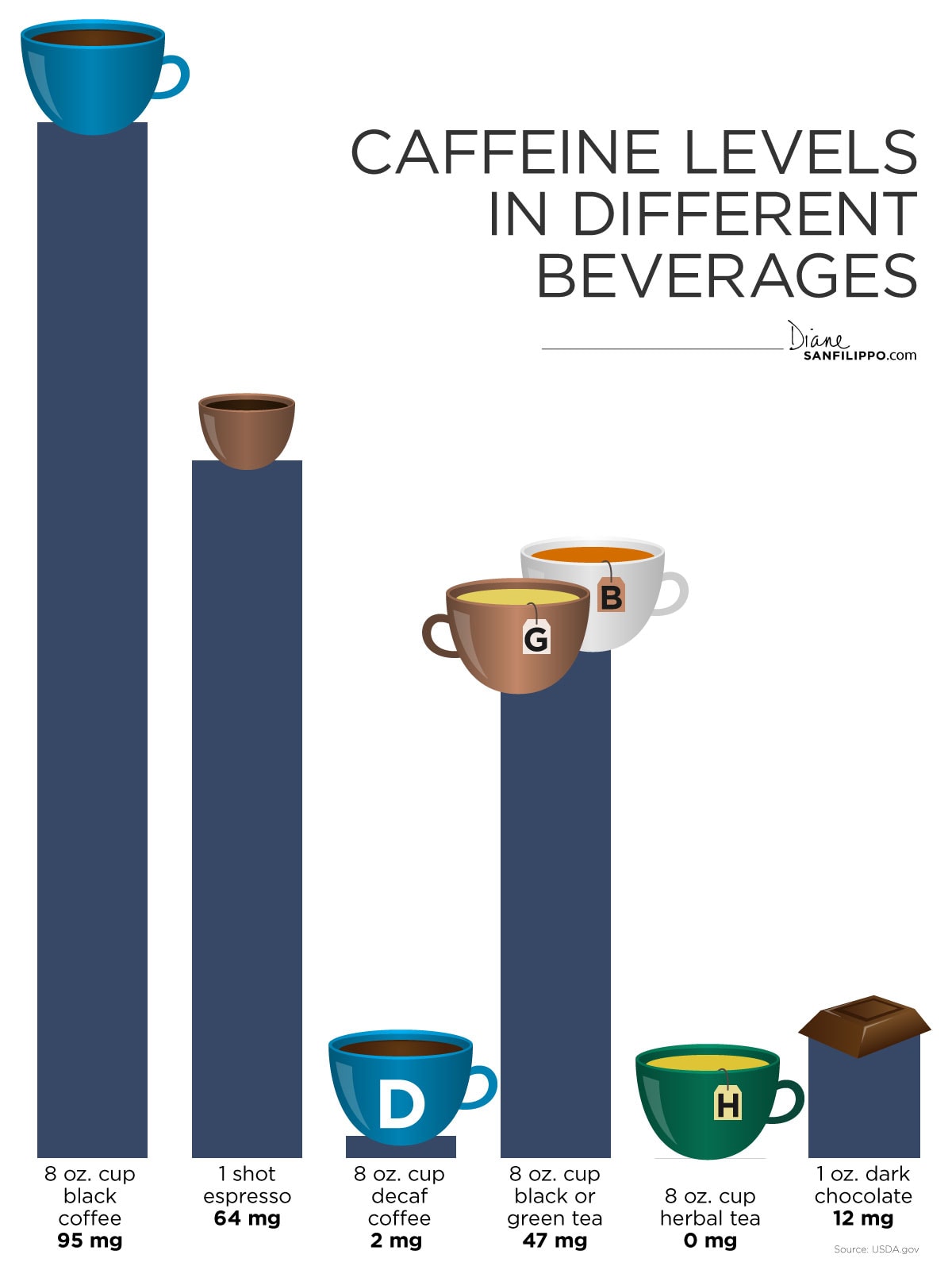Today we have a special guest post for you, that comes to us from Rachel Fiske, a Holistic Nutrition Consultant, graduate of Bauman College of Holistic Nutrition, and a Certified Personal Trainer through the National Academy of Sports Medicine. Rachel works with individual clients, focusing on issues of weight management, GI problems, hormonal imbalances, fatigue and more via a whole foods diet and lifestyle changes.
Coffee 101: What's In It, Toxicity Levels, & Caffeine
Coffee is the most commonly consumed beverage after water, yet you might be confused about its health risks and benefits. A typical cup contains roughly 100 mg of caffeine, and also provides a wide variety of nutrients and antioxidants. For you coffee drinkers out there, the bottom line is this: for many people, coffee can be a healthy part of a balanced diet, and even offer some real benefits. However, if you suffer from anxiety, insomnia, or certain other conditions, you might need to reconsider.
What’s in a cup of coffee?
Aside from caffeine which is the main ingredient, an 8 oz. cup of coffee contains the following nutrients, all in quantities under 10% of RDA recommendations: Vitamins B1, 2, 3 and 5 (B2 in the highest quantity at 11%), folate, manganese, potassium, magnesium and phosphorus.[1] Also, coffee contains high amounts of antioxidants such as hydrocinnamic acids and polyphenols, which are important in protecting our bodies against free radical damage (molecules that can damage our cell structure).[2]
Also keep in mind that the type of roast you choose is directly connected to the amount of antioxidants in any given coffee. Studies have shown that light and medium roasts have higher antioxidant profiles than a darker roast.[3]
The Federal Drug Administration’s toxic dose of daily caffeine consumption is set at 10 grams, while your morning coffee has anywhere between 100-200 mg. Caffeine is an alkaloid, which is a group of naturally occurring compounds that contain primarily nitrogen atoms and are found in many plants, animals and other organisms in nature.
How to choose non-toxic coffee
There has been a lot of attention recently on mycotoxins, which are toxic chemicals produced by certain molds that can grow on foods such as grains, coffee, and peanut butter. While these chemicals can undeniably be harmful in high doses, the amount found in some coffee beans and the drink itself is well under the safety limit. Here are a few tips on how to choose non-toxic coffee:
- Drink regular vs. decaf coffee, as caffeine is an antifungal and actually works as a protective agent against the presence of toxins potentially found in coffee.
- Choose wet roasted coffee beans, as many mycotoxins are formed in the drying process.
- Avoid coffee “blends”. These are typically lower quality coffee beans and the consumer has no way of knowing where the beans originated and what processes they have been exposed to.
- Choose beans grown at higher elevations where molds are less likely to grow.[4]
Caffeine
Whether or not caffeine is harmful really depends on the individual and their specific level of caffeine sensitivity. A person’s degree of sensitivity depends on their genetic make-up, specifically, the activity of a certain enzyme responsible for caffeine metabolism.
Caffeine prompts our adrenal glands to secrete the hormone adrenaline, therefore acting as a stimulant. Our adrenal glands are two grape-sized glands located near our kidneys, and they are responsible for producing our bodies’ stress hormones, including adrenaline. Now, this is not necessarily a bad thing for all coffee drinkers, but for those that suffer from symptoms of anxiety, insomnia, adrenal fatigue and/or are a slow metabolizer, you can experience negative side effects such as nervousness or even increased risk of heart attack.[5]
While coffee contains the highest concentration of caffeine, other natural food sources include cocoa beans, kola nuts, yerba mate, black, green and white teas. In non-natural forms, caffeine is found in many sodas, energy drinks, and decaf coffee, as well.
Geek’s Corner
For you science nerds out there, you might be interested to know that caffeine is first absorbed in the small intestine, and then metabolized in the liver cells prior to distribution amongst bodily tissues about 45 minutes after ingestion. Its half life is typically 3-5 hours in adults; however, in some this time is greatly increased, even up to 80 hours (specifically pregnant women).
 Rachel Fiske is a Holistic Nutrition Consultant and graduated from Bauman College of Holistic Nutrition in Berkeley, California, and a Certified Personal Trainer through the National Academy of Sports Medicine. Rachel works with clients individually via Skype, focusing on issues of weight management, GI problems, hormonal imbalances, fatigue and more via a whole foods diet and lifestyle changes. Consultations include diet journal analysis, individualized menu planning, and herbal/supplementation protocols. You can learn more about Rachel here.
Rachel Fiske is a Holistic Nutrition Consultant and graduated from Bauman College of Holistic Nutrition in Berkeley, California, and a Certified Personal Trainer through the National Academy of Sports Medicine. Rachel works with clients individually via Skype, focusing on issues of weight management, GI problems, hormonal imbalances, fatigue and more via a whole foods diet and lifestyle changes. Consultations include diet journal analysis, individualized menu planning, and herbal/supplementation protocols. You can learn more about Rachel here.
If you suspect adrenal fatigue or suffer from some of the symptoms mentioned in this article, feel free to email Rachel for a free 15 minute phone consultation, to see if she can help you with a personalized nutrition plan.
Footnotes
[1] USDA SR-21, Coffee, brewed from grounds, prepared with tap water, accessed February 16th, 2016.
[2] http://authoritynutrition.com/coffee-worlds-biggest-source-of-antioxidants
[3] “Effect of processing and roasting on the antioxidant activity of coffee brews.” Food Science and Technology (Campinas) I678-457X, Scielo. Web. February 16, 2016.
[4] http://www.naturalnews.com/034063_mycotoxins_coffee.html#
[5] Cornelius MC, El-Sohemy A, Kabagambe EK, Campos H. “Coffee, CYP1A2 genotype, and risk of myocardial infarction.” Journal of the American Medical Association. 1135-41 (2006). Pubmed. Web. February 16, 2016.

